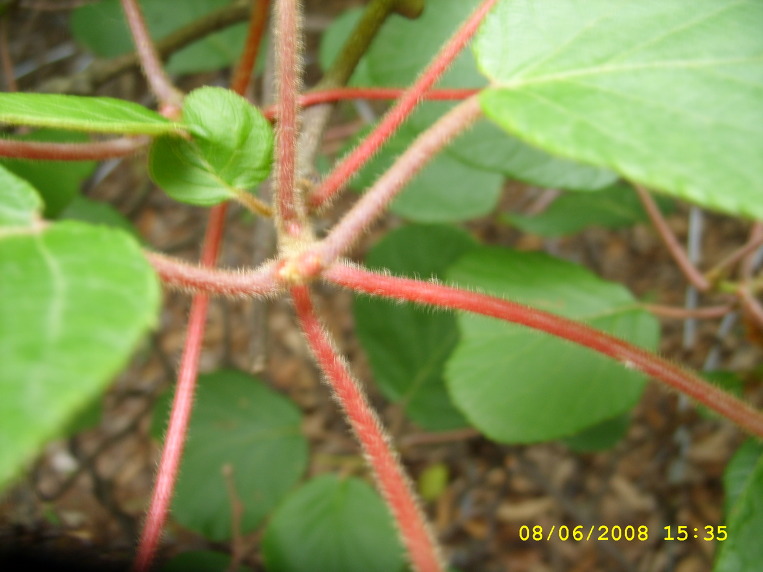쥐다래(1)
https://daehyo49.tistory.com/7808022
쥐다래(2)
https://daehyo49.tistory.com/7815182
개다래(1)
https://daehyo49.tistory.com/7808299
개다래(2)
https://daehyo49.tistory.com/7814107
다래/개다래/쥐다래/오미자 잎 비교
https://daehyo49.tistory.com/7811609
섬다래
https://daehyo49.tistory.com/7811688
다래
https://daehyo49.tistory.com/7812759
참다래(양다래, 키위, 호미다래)
https://daehyo49.tistory.com/7807489
분류 : 다래나무과(Actinidiaceae)
사진 : 물향기수목원
두 종이 있다
1)
학명: Actinidia chinensis var. deliciosa (A. Chevalier) A. Chevalier
Actinidia deliciosa (A. Chev.) C. F. Liang & A. R. Fergusen로 승격시켜 쓰기도 한다
일어명: キウイフルーツ (약칭: キウイ)
중국어명: 美味猕猴(미후-원숭이)桃
영명: kiiwi (fruit)
* 촤근 국표식에서는 호미다래로 국명을 올렸으나 오랫동안 사용해온 참다래나 양다래를 사용하지 않고 갑작이 호미다래로 국명을 바꾼 것은 적절하지 않다고 본다
2)
학명: Actinidia chinensis var. chinensis
일어명: オニマタタビ(A. chinensis、ゴールドキウイ、ゴールデンキウイ
중국어명: 中华猕猴桃
* 최근 국표식에는 중국다래로 이름이 올라와 있다




아래: 2019.11.09 안면도



아래 : 2023.05.07 청평





아래 : 2023.07.14 파주 읍내리


참다래에 대한 위키백과의 설명:
키위는 Actinidia deliciosa 와 Actinidia deliciosa 와의 다른 다래나무속 식물을 교배하여 만든 과일 품종이다. 참다래란 이름은 1990년대 대한민국 농가에서 생산된 제품에 붙은 뒤 일반화되었으며 지금도 다른 나라에서 생산된 제품은 양다래나 키위란 이름으로 부르는 경우가 많다. 키위란 이름은 뉴질랜드의 나라새인 키위와 닮았다 해서 붙여졌다. 달걀모양으로 생겼으며 털이 달린 갈색의 껍질을 갖고 있다. 과육은 연두색 혹은 금색이며 작고 검은 씨들이 박혀 있다. 금색의 키위는 골드키위란 이름으로 불리워지기도 한다. 맛은 딸기.바나나. 파인애플을 혼합한 듯하나. 수확 후 충분한 숙성기간을 거치지 않으면 신맛이 강하다. 때문에 참다래는 후숙 과일로 분류된다. 참다래는 원래 중국 남부에서 자라는 식물이었으나 20세기 초에 뉴질랜드에 재배되기 시작하였다. 때문에 초기에는 '차이니즈 구즈베리'란 이름으로 상품화되었다. 헤이워드 품종이나 그와 유사한 품종이 일반적으로 경작되지만 과육이 노란색인 금다래(골드키위)도 재배된다.
참다래 이름의 역사:
키위는 우리나라에 1974년 도입되어 제주도 및 남해안 일대 일부농가에서 재배되기 시작하였다. 처음에는 '양다래'란 이름으로 통용 되어오다가 1997년 '참다래'로 개칭되었다.
참다래 학명과 관련하여
참다래 학명은 좀 혼란스럽다. 이미 소개한 것처럼 우리나라 위키백과에서는 Actinidia deliciosa 로 적혀 있으니 네이버백과(두산백과사전)에는 Actinidia chinensis로 되어 있고 en.wikipedia.org에는 Actinidia deliciosa 의 synonym으로 Actinidia chinensis deliciosa를 들고 있다. 또 어떤 곳에는 (H2O- NETWORK http://blog.naver.com/nstdaily/150004372009)에는 Actinidia deliciosa (A. Chev.) CF Liang & AR Ferguson)를 Actinidia chinensis Hort. non Planch 와 같은 것으로 하였다. 그러나 다래 전문가가 기록한 것으로 보이는 아래 사이트의 글을 보면 Actinidia deliciosa 와 Actinidia chinensis는 다른 품종인 것으로 봐야할 것이다
네이버 블로그 야생마 - 다래의 분류http://blog.naver.com/fe10/39024655
줄기와 과실 표피에 털이 있는 것:A. deliciosa, 털이 없는 것:A.chinensis
외국의 인터넷 사이트 http://www.hort.purdue.edu/newcrop/proceedings1999/v4-342.html
(New Temperate Fruits: Actinidia chinensis and Actinidia deliciosa A.R. Ferguson*)를 보면 이 점이 분명히 나타난다. 이런 점들을 본다면 우리가 참다래(보통 키위 또는 양다래라 부른다) 부르는 종의 학명은 Actinidia deliciosa (A. Chev.) CF Liang & AR Ferguson)로 해야 할 것이다.
아래는 Flora of China의 설명이다
Actinidia chinensis Planchon, London J. Bot. 6: 303. 1847.
中华猕猴桃 zhong hua mi hou tao
(설명)
Climbing shrubs, large, deciduous. Branchlets reddish, with paler oblong lenticels, young branchlets white pubescent to brownish long strigose or densely ferruginous hispid-setose; pith whitish to brown, large, lamellate. Petiole 3-6(-10) cm, white pubescent or brownish long strigose to densely ferruginous hispid-setose; leaf blade abaxially pale green, adaxially dark green, broadly ovate to broadly obovate or suborbicular, 6-17 × 7-15 cm, papery, abaxially whitish or brownish stellate tomentose, adaxially usually glabrous, occasionally ± puberulent, especially more densely so on midvein and lateral veins, or densely scabrid-hispid throughout, midvein and lateral veins conspicuous abaxially, subconspicuous adaxially, lateral veins 5-8 pairs, furcate above middle, veinlets in parallel cross-bars, conspicuous abaxially, base rounded to truncate to cordatulate, margin setose-serrulate with teeth terminating tips of veinlets, apex truncate to emarginate to abruptly cuspidate or shortly acuminate. Inflorescences cymose, 1-3-flowered, white silky-tomentose or yellowish brown velutinous; peduncles 0.7-1.5 cm; pedicels 0.9-1.5 cm; bracts linear, ca. 1 mm. Flowers orange-yellow. Sepals (3-)5(-7), broadly ovate to oblong-ovate, 6-10 mm, both surfaces densely yellowish tomentose. Petals (3-)5(-8), rarely with a second whorl of 2 smaller petals, broadly obovate, 1-2 cm, shortly clawed at base, rounded at apex. Filaments 5-10 mm; anthers yellow, oblong, 1.5-2 mm, sagittate at base or not, apex acute to rounded. Ovary globose, ca. 5 mm in diam., densely golden villous. Fruit subglobose to cylindric to obovoid or ellipsoidal, 4-6 cm, densely tomentose when young, glabrous when mature to densely hispid, with many brownish lenticels; persistent sepals reflexed. Fl. Apr-May, fr. Sep. 2n = 58*, 116*, 174*.
Mountain forests, sparse secondary forests, tall grassy thickets on low mountains, thickets; 200-2600 m. Anhui, Chongqing, Fujian, Gansu, Guangdong, Guangxi, Guizhou, Henan, Hubei, Hunan, Jiangsu, Jiangxi, Shaanxi, Sichuan, Taiwan, Yunnan, Zhejiang.
The producer of kiwifruit, this taxon is widely cultivated in China and elsewhere.
Actinidia chinensis var. lageniformis S. Y. Wang & C. F. Chen (J. Henan Agric. Coll. 4: 82. 1981) and A. chinensis var. nephrocarpa S. Y. Wang & C. F. Chen (loc. cit.), both described from Henan, could not be treated here because no material was seen by the authors.
FOC의 Actnidia chinensis의 아종 분류 번역
1. 어린 가지와 엽병에 백색 연모 내지 거친 면모 (tomentose; 綿毛; 짧은 솜털),
자라면 매끈해지거나 좀 남는다; 열매에도 면모가 밀생하나 차자 없어진다
................. Actinidia chinensis var. chinensis
1. 어린 가지와 엽병에 갈색-적갈색의 강모; 대체로 쉽게 없어지지 않는다;
열매에도 강모 밀생; 성숙해도 다소 남는다
2. 강모는 갈색이며 굽은 강모(strigose)이다
잎 표면은 보통 무모
................. Actinidia chinensis var. deliciosa
2. 강모는 적갈색(ferruginous)으로 곧은 강모이다(hispid-setose);
잎의 표면에도 거칠거칠한 강모(scabrid-hispid)가 있다
................. Actinidia chinensis var. setosa
* strigose는 원래 표면 가까이에서 굽어 표면과 평행한 강모를 의미하나 흔히 hispid와 구분없이 사용한다.
아래 세밀화는 FOC에서 퍼온 것이다

일본 위키에서 퍼온 다래 종류들의 열매 구별 사진

A = A. arguta,(다래) C = A. chinensis (키위1), D = A. deliciosa (키위2),
E = A. eriantha, I = A. indochinensis, P = A. polygama (개다래), S = A. setosa.
출처: https://ja.wikipedia.org/wiki/%E3%82%AD%E3%82%A6%E3%82%A4%E3%83%95%E3%83%AB%E3%83%BC%E3%83%84